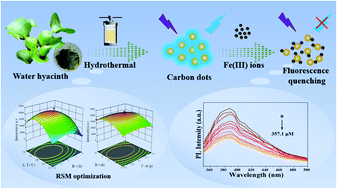Fluorescent carbon dots from water hyacinth as detection sensors for ferric ions: the preparation and optimisation using response surface methodology†
Abstract
The search for alternatives to chemicals from natural products as precursors for the preparation of highly doped carbon dots (CDs) remains challenging. Novel CDs (W-CDs) were synthesised using a one-step pyrolysis method with wastewater hyacinth as the sole carbon and nitrogen source at a mild temperature without using any surface-activating reagents or salt. The obtained W-CDs emitted strong blue fluorescence under 365 nm UV light excitation, with a quantum yield of 15.12%. The Box–Behnken design of the response surface methodology was applied to optimize the W-CD preparation conditions, including the reaction temperature, reaction time and weight of water hyacinths. The temperature was found to be the most important factor affecting the fluorescence intensity of the W-CDs. Additionally, the fluorescence sensor based on W-CDs demonstrated excellent selectivity towards ferric (Fe) ions, with a limit of detection of 2.35 μM. The fluorescent sensor was successfully applied for detecting Fe3+ in real water samples with a recovery of 97.80–103.10%. Hence, the pyrolysis of water hyacinth is proven to be a rapid, effective and green approach for CDs and provides a novel method for recycling water hyacinth.



 Please wait while we load your content...
Please wait while we load your content...